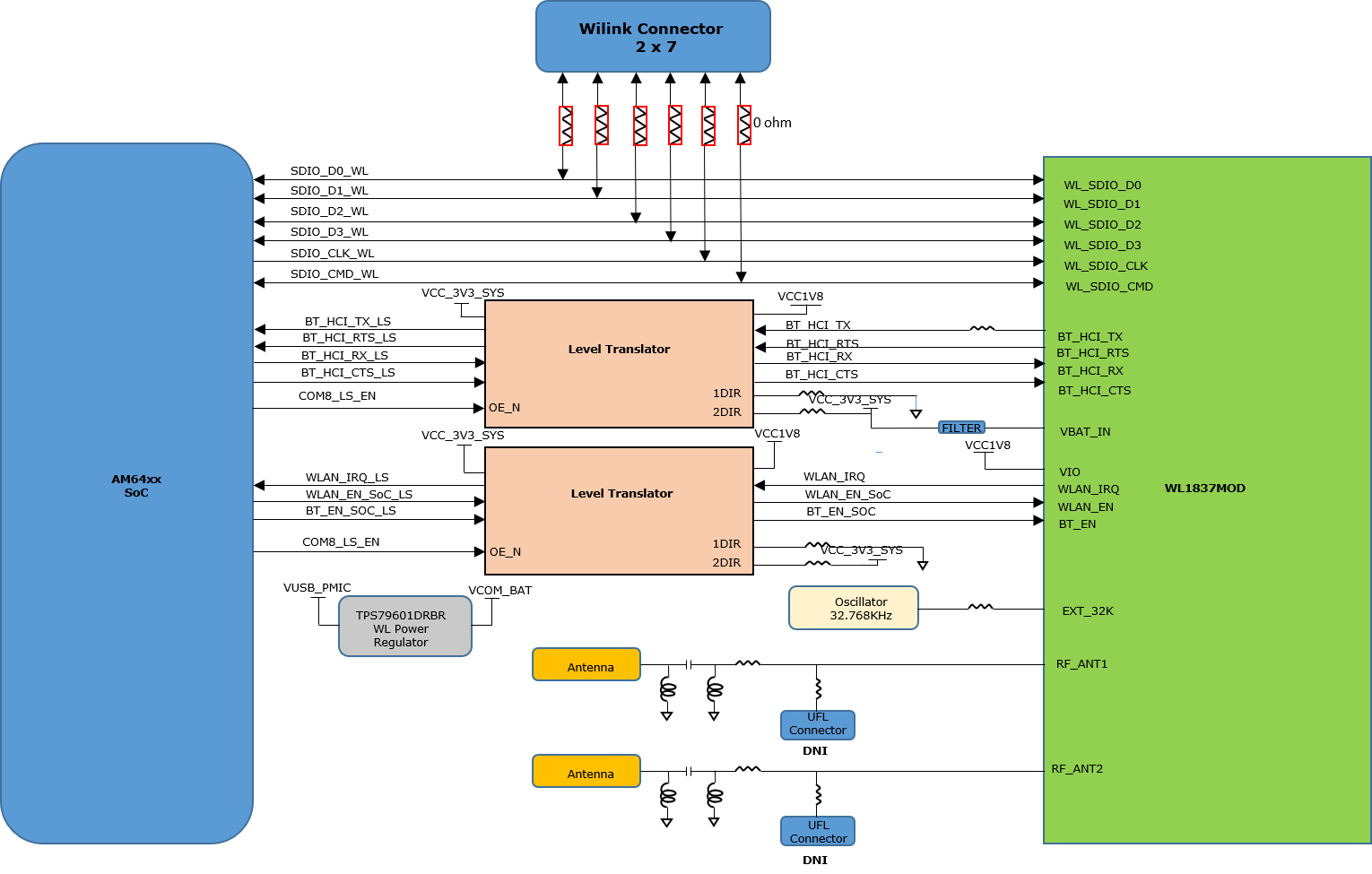SPRUJ64 September 2022
- Abstract
- Trademarks
- 1Key Features
- 2AM64x SKEVM Overview
- 3Functional Block Diagram
-
4System Description
- 4.1 Clocking
- 4.2 Reset
- 4.3 Power Requirements
- 4.4 Configuration
- 4.5 JTAG
- 4.6 Test Automation
- 4.7 UART Interface
- 4.8 Memory Interfaces
- 4.9 Ethernet Interface
- 4.10 USB 3.0 Interface
- 4.11 PRU Connector
- 4.12 User Expansion Connector
- 4.13 MCU Connector
- 4.14 Interrupt
- 4.15 I2C Interface
- 4.16 IO Expander (GPIOs)
- 5Known Issues and Modifications
- 6Revision History
4.8.2.2 WiLink Interface
The SKEVM board has WiLink Module (WL1837MODGIMOCT) from TI connected to the MMC0 port of the AM64x SoC. The WL1837MOD is a Wi-Fi, dual-band, 2.4- and 5-GHz module solution with two antennas supporting Industrial temperature grade. The Module is connected to 4-bit IO of the MMC0 interface supporting IEEE standard 802.11a/b/g/n data rates with 20 or 40-MHz SISO or 20-MHz MIMO. The Module offers high throughput and extended range along with Wi-Fi and Bluetooth coexistence in a power-optimized design.
The device supports the following Bluetooth features:
- Bluetooth 4.2 secure connection as well as CSA2
- Concurrent operation and built-in coexisting and prioritization handling of Bluetooth and Bluetooth low energy wireless technology, audio processing, and WLAN
- Dedicated audio processor supporting on-chip SBC encoding + A2DP
- Assisted A2DP (A3DP): SBC encoding implemented internally
- Assisted WB-speech (AWBS): modified SBC codec implemented internally. Figure 4-10 shows the block diagram of Wilink module interfaced with AM64x.
SKEVM does not support A2DP BT Audio profile or HF profile.
The Module requires two power supplies, 3.3 V for VBAT_IN and 1.8 V for VIO_IN. The MMC0 interface of SOC is powered by VDDSHV_MMC0 power supply, which is connected to 1.8-V IO supply. Bluetooth UART signals, enable of BT and WLAN and WLAN_IRQ signals are connected to GPIO’s of AM64x using level translator (SN74AVC4T245RSVR). Input clock is provided by using 32.768 KHz oscillator (ASDK2-32.768KHZ-LRT).
Test points are provided on MMC0_DAT [4:7] pins of SOC and WL_GPIO, BT_UART_DEBUG, WL_UART_DEBUG pins on WL1837 Module.
A 14-pin Wilink connector is also provided. An external Wi-Fi module (Bluetooth module is not supported) can be communicated with SoC through the 14-pin WiLink connector. By default, the 14-pin Wilink connector and 0E resistors are not populated on the signals which are connected to the 14-pin Wilink connector.
 Figure 4-10 WiLink Module Interface
Figure 4-10 WiLink Module Interface